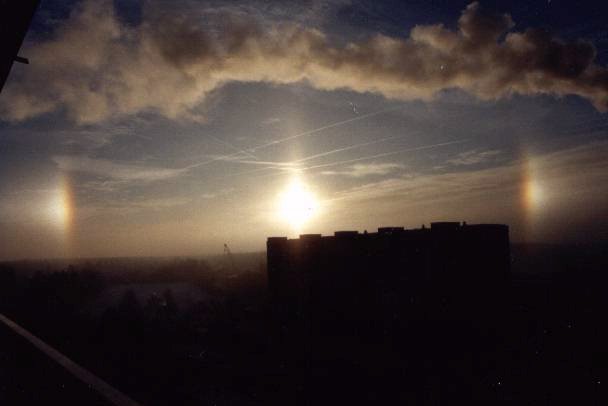- Crystal orientation:
- Basis horizontal
- Path of light:
- 3-7
- Occurrence:
- very frequently
60-80 Tage days a year
EE 02/03/04

Description:
The bright spots of light on the suns right and left are called parhelia. They can be found at the altitude of the sun, parallel to the horizon. When the sun is low, they are placed at an angle of 22°. So they lie on the little ring. As the sun rises, they move more and more away from the 22°-halo. When the sun elevation is at 40° above the horizon, the parhelia are at an angle of about 27.6°. Sundogs often have intensive colours. Towards the sun they are red, and. when they are fully developed they have a long white tail pointing away from the sun parallel to the horizon. In special cases they can be of an almost dazzling brightness.
sun- distance length elevation sun-parhelia of tail
0° 22° 21,5° 10° 22° 21,5° 20° 23° 20,5° 30° 25° 19° 40° 28° 16° 50° 32° 13° 60° 45° 7°
Correlation between sun elevation and length of white trail (G. Berthold, Chemnitz)
Formation:
Parhelia or sundogs are generated by plate-shaped hexagonal ice prisms. When falling undisturbed, the plates automatically orientate horizontally. The sunlight enters one face of the prism and exits the next but one. Of special interest is the connection between the parhelia and the circumzenithal arc. Both are caused by plate-shaped ice crystals which are orientated horizontally. Thus if there are sundogs in the sky, you can also reckon with the appearance of the circumzenithal arc, especially when the sun elevation is between 15° and 25°.


